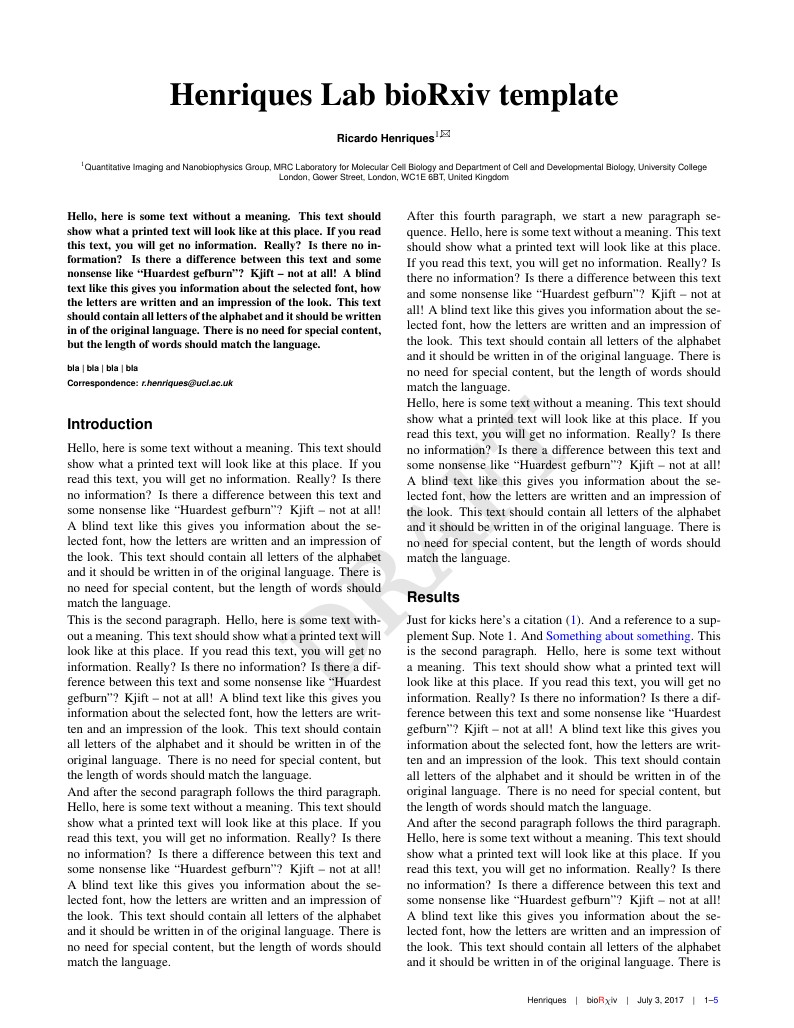overleaf template galleryLaTeX templates and examples — Recent
Discover LaTeX templates and examples to help with everything from writing a journal article to using a specific LaTeX package.

This is a gorgeous template for bioRxiv pre-prints. An example manuscript using it can be found here.

Handouts should be made to complement serious presentations. The purpose of this handout is to summarize the Edward Tufte lecture on June 16th, 2016 in Chicago. Tufte began and ended his lecture wordlessly with a clip from the Music Animation Machine project and it is one of the metaphors used for the beautiful potential of clarity in information display. Relatively large amounts of information are displayed in context; the data contains the past, present, and future, and in a short matter of time, the viewer can predict the duration, pitch and sound of the notes heard based on the visual experience of the data. This is a beautiful metaphor for the potential of immediate visual context in multiscale imaging.

BACHELOR'S THESIS TEMPLATE - ENGLISH cslatex can be used instead of latex pdflatex or pdfcslatex can be used if certain parts are adjusted AUTHORS: Martin Mares (mares@kam.mff.cuni.cz) Arnost Komarek (komarek@karlin.mff.cuni.cz), 2011 Michal Kulich (kulich@karlin.mff.cuni.cz), 2013 Štěpán Doan (stepan.doan@fjfi.cvut.cz,2017 LAST UPDATED: 20170630

This is the official template for preparing submissions to Australian & New Zealand Journal of Statistics, which uses the anzsauth.cls document class and anzst.bst bibliography files. Use of this document class and bibliography style will make it much easier for you to prepare your paper in a manner conforming to the journal's requirements. Please refer to the journal’s author guidelines in order to confirm your manuscript adheres to the journal’s requirements for submissions. Once your manuscript is complete, simply use the "Submit to Journal" option in the Overleaf editor to submit your files directly to the journal for processing. If you're new to LaTeX, check out our free online introduction to help you get started, or please get in touch if you have any questions.

With the start of the new academic year in 2014, Radboud University Nijmegen, the Netherlands, introduced a new corporate style. They provide official Powerpoint and Keynote themes, but have not, and will not, provide a LaTeX Beamer theme. Currently the corporate style, and the second-tier styles for Software Science, Data Science, Kaski, PTRS, IMR, SteR, CLS, CLST, DS, IS, MBSD, iCIS and HCLS are implemented. Initial support for group logos: lama. New support for the 2017 style in 16:9 format. Feel free to use this theme, I tried to adhere to the provided guidelines as well as I could, but in case there are any problems, suggestions, or comments, let me know at l.onrust@let.ru.nl or visit the github repository on https://github.com/naiaden/presentations/tree/master/ruhuisstijl/distributed You can distribute and edit the files as you wish, but I'd love to hear of any changes. Also, if you let me know that you are using the template, I can keep you up-to-date on future changes.

This is a template for documents created by the Science Student Union, LUNA at Lund University, Sweden.

This project uses LuaTeX to draw nodes graphs representing the inner structure of TeX boxes. The node graphs are output in PDF and SVG format for digital- or print-based usage. This project was written to accompany the blog post Pandora’s \hbox: Using LuaTeX to Lift the Lid of TeX Boxes.

A study tool. Equations are mostly listed without a description of what they represent. Topics are detailed based on problems. Usage: To prepare for the Calculus BC exam, go through topics one at a time and mentally describe the problem, process, and equations involved. If you get stuck - look up the answer and start again from the top. When you can get through the entire sheet - you're ready! Do the same with the equation list - describing exactly what type of problems you might need the equation for. Do not use notes in conjunction with the review sheet. Look up the answer - close the book and start again! You can thank me later.

Article template for the Journal for Modeling in Ophthalmology. Journal for Modeling in Ophthalmology (JMO) was created in 2014 with the aim of providing a forum for interdisciplinary approaches integrating mathematical and computational modeling techniques to address open problems in ophthalmology Downloaded from the journal website on 3 June 2017. One minor fix to a biblatex style issue in the .cls file, but otherwise unmodified.
\begin
Discover why over 20 million people worldwide trust Overleaf with their work.